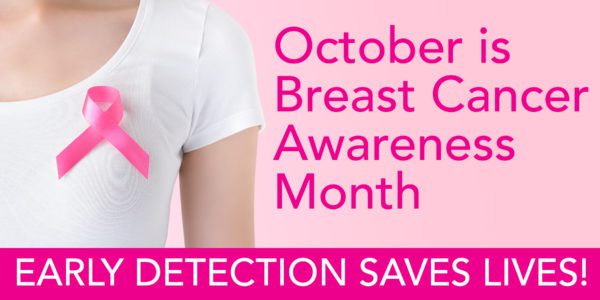
Breast cancer is the most common cancer in women, after skin cancers, but breast cancer can be successfully treated. During October, Breast Cancer Awareness Month, pink ribbons are worn to help raise awareness about the importance of early detection. On National Mammography Day. Friday, October 21, everyone is encouraged to wear pink in support of breast cancer survivors and to help raise awareness of screening mammography as a life-saving diagnostic tool.
In the fight against breast cancer, knowledge is a powerful tool, in addition to screening. It is important to:
Know your risk (and know what is normal for you)
- Talk to both sides of your family to learn about your family health history
- Talk to a doctor about your risk of breast cancer
- See a doctor if you notice any changes such as a lump, knot or thickening inside the breast or underarm area; swelling, warmth, change in appearance; dimpling or puckering of the skin; sore or rash on the nipple or bloody discharge from the nipple.
Make healthy lifestyle choices
- Maintain a healthy weight
- Add exercise into your routine
- Limit alcohol intake
- Limit menopausal hormone use
- Breastfeed, if you can
Start annual screening mammography at age 40 The third Friday of October is designated as National Mammography Day, to raise awareness that screening tests can find cancer early, when chances for survival are highest. Some statistics regarding annual screening mammography are listed here.
- Talk with a doctor about which screening tests are right for you if you are at higher risk.
- Have a mammogram every year starting at age 40 if you are at average risk.
- Annual screening mammography starting at age 40 results in the greatest mortality reduction, the most lives saved and the most life years gained.
- Breast cancer incidence increases substantially around age 40. The incidence rate for ages 40-44 is twice that for ages 35-39 (122.5 vs 59.5 per 100,000 women).
- One in six breast cancers occurs in women aged 40-49.
- The years of life lost to breast cancer are highest for women in their 40’s.
- Annual screening results in more lives saved from breast cancer than biennial screening. The United States Preventive Services Task Force (USPSTF) scientific review now shows annual screening beginning at age 40 provides the most lives saved.
- The largest (Hellquist et al) and longest running (Tabar et al) breast cancer screening trials in history have reconfirmed that regular mammography screening cuts breast cancer deaths by roughly a third in all women ages 40 and over (including women ages 40-49).
- Mammography has helped reduce breast cancer mortality in the U.S. by nearly 40% since 1990. One study shows mammography screening cuts the risk of dying from breast cancer nearly in half.
- Three out of four women diagnosed with breast cancer have no family history of the disease and are not considered high risk.
York Hospital Breast Care has locations in York and in Wells; please visit the Breast Care web page for more information about the expert care and services offered. If you have additional questions, please contact Community Relations at (207) 351-2385 or [email protected].
For further reading: https://www.cdc.gov/cancer/dcpc/resources/features/breastcancerawareness/index.htm ; Mammograms – What You Should Know | Susan G. Komen®.

